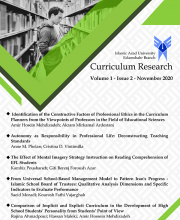Designing, Implementing and Evaluating a Learning Situation to Achieve the Goals of Economic Education Field in the Third Grade of Elementary School(مقاله پژوهشی دانشگاه آزاد)
Purpose: The present study aimed to design, implement and evaluate a learning situation to achieve the goals of economic education in the third grade of elementary school. Methodology: This research is applied in terms of purpose and is a quasi-experimental research in terms of method. The research design of this study is a pre-test/post-test design with a control group. The sample of this study were 50 third grade female students of Dr. Hesabi School in District 20 of Rey city who were divided into control and experimental groups. In order to collect data, a researcher-made checklist was used. The validity of the questionnaire was content-face validity and was confirmed by educational planning experts. The reliability of the questionnaire was calculated based on Cronbach's alpha value and was more than 70% and was confirmed. For data analysis, mean and standard deviation indices as well as Kolmogorov–Smirnov test, covariance and SPSS software version 20 were used. Findings: Findings showed that there is a significant difference between students' perceptions of the concepts of economic education in the experimental group and the control group in the pre-test and post-test stages and the designed learning situation has been able to influence third grade students' understanding of the economic concepts of benefit, cost, and consumption. The results show that the average benefit variable in the experimental group post-test was 4.80, the average cost variable in the experimental group post-test was 5.20 and the average consumption variable in the post-test of the experimental group was 9.64. Conclusion: According to the results, it can be said that the learning situation designed to convey the concept of consumption has been more successful than the other two concepts. This is rooted in the lack of sufficient economic resources appropriate to the student's age group (especially the issue of benefit).
